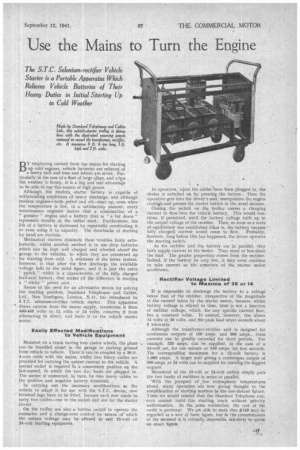Use the Mains to Turn the Engine
Page 19

If you've noticed an error in this article please click here to report it so we can fix it.
By employing current from the mains for starting up cold enEines, vehicle batteries are relieved of a heavy task and time and labour are saved. Par-. ticularly in the case of a fleet of large °ilea's, and when 'the weather is frosty, it is a big and real advantage to be able to tap this source of high power.
Although the modern, starter battery is capable of withstanding conditions of heavy discharge, and although modern engines-,-both petrol and oil—start up, even when • the temperature is low, in a satisfactory manner, every maintenance engineer knows that a combination of a "
gummy" engine and a battery that is "a bit down" represents trouble at the initial start. Furthermore, the life of a battery is shortened by repeatedly overloading it or even using it to capacity. The drawbacks of starting by hand are obvious.
Mechanical starters eliminate these troubles fairly satisfactorily. whilst another method is to use shop batteries • which can be. kept well charged and wheeled about' the garage to the vehicles, to which they are connected up for starting from cold. A weakness of the latter system, however, is that after the first discharge the available voltage falls to the rated figure, and it is just the extra, " punch," which is a characteristic of the fidly charged lead-acid battery, that makes all the difference in starting a " sticky " power unit.
Aware of the need for an alternative means for solving the starting problem, Standard Telephones and. Cables, Ltd., New Southgate, London, N.11, has introduced its S.T.C. selenium-rectifier -vehicle starter. This apparatus draws current from the mains supply, transforms it from 400.440 volts to 12 volts or 24 volts, converts it from alternating to direct, and feeds it to the vehicfe starter motor.
Easily Effected Modifications to Vehicle Equipment
Mounted on a truck having four castor wheels, the plant can be trundled about in the garage or parking ground from vehicle to vehicle. There it can be coupled by a 30-ft. 4-core cable with the mains, whilst two heavy cables are provided for carrying The output current to the vehicle. A special socket is required In a convenient position op the. last-named, to which the two d.c: leads are plugged in. The socket is connected, in turn, by two heavy cables to the positive and negative battery terminals. .
In carrying out the necessary modifications to the vehicle to adapt it for use with the S.T.C. device,, new terminal lugs have to be fitted, because each now needs to carry two cables—one to the socket and one for the starter circuit.
On the trolley are also a button switch' to operate the contactor and a change-over control by means ofwhich the output voltage may be altere4 to suit 12-volt or 24-volt starting equipment. In operation, ,vjten the cables have been plugged in, the device is switched on by pressing the button. Then the operative gets into the driver's seat, manipulates the engine contrgls and presses the starter button in the usual manner.
Closing the switch on the trolley causes a charging current to flow into the vehicle battery. This would continue, if permitted, until the battery voltage built up to the output voltage of the rectifier. Then, so soon as a state of equilibrium was established(that is, the battery became fully charged) current would cease to flow. Probably, ,however, long before this has happened, the driver operates the starting switch.
As the rectifier and the battery are in parallel, they both supply current to the motor. They more or lass-share. the load. • The greater proportion comes from the rectifier. 'Indeed, if the battery be very .low, it may even continue to take current as the armature of the starter motor accelerates.
• Rectifier Voltage Limited •• to Maxima of 28 or 14.
It is impossible to discharge the battery to a voltage below that of the rectifier, irrespective of the magnitude of .the current taken by the starter motor, because, whilst. battery voltage is related to time, time is not a function of rectifier voltage, which, for any specific current flow, has a constant value. It cannot, however, rise above 14 volts or, 28 volts, and the-peak load never exceeds about 5 kilowatts.
Although the transformer-rectifier unit is designed for continuous outputs of 150. amps. and 300 amps., these currents can be greatly exceeded for short periods. For example, 225 amps. can he .supplied, in the case of a 24-volt set, for one minute or 540 amps*. for five seconds. The corresponiling maximum for a 12-volt battery is 1,080 amps.. A larger unit giving a continupus output of 300 amps. at 24 volts caat be supplied for starting the biggest engines.
Movement of the 12-volt or 24-volt switch simply puts the two banks of rectifiers in series or parallel.
With the. prospect of slow atmospheric temperatures ahead, many operators are now giving thought to the simplification of starting matters in the not-distant future.Thesewe would remind that the Standard Telephone concern cannot build this starting truck without 'priority authorization. In the same connection, the cost of the outfit is pertinent. We ate able to state that £140 may be regarded as a sort of basic figure, but in the circurhstances of the moment it is virtually impossible definitely to quote an exact figure.




















































